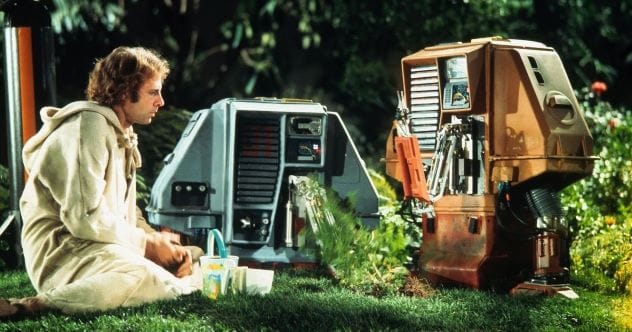When we talk about movie magic, a few names shine brighter than others. Douglas Trumbull is definitely one of them. His incredible work on special effects for movies like 2001: A Space Odyssey, Close Encounters of the Third Kind, and Blade Runner made him a true legend. Trumbull passed away in February 2022 at 79, but his amazing creations continue to inspire us. Let’s dive into some cool facts about the life of this extraordinary filmmaker and special effects master.
10 A Family of Innovators
Douglas Trumbull was born on April 8, 1942, in Los Angeles, California. Living close to Hollywood was a plus, but talent ran in his family. His father, Don Trumbull, was an aerospace engineer. Interestingly, Don also worked on special effects for the original Star Wars (1977) and the classic The Wizard of Oz (1939), a film famous for its early visual effects. Though his father’s film work picked up after Douglas found success, they later collaborated on movies like Close Encounters of the Third Kind and Star Trek: The Motion Picture. It’s clear that a gift for visual artistry was a Trumbull family trait.
9 Early Fascination with Electronics
Growing up in California, young Trumbull was captivated by how mechanical and electronic things worked. He even built his own crystal set radios. These simple radios could pick up signals and even power themselves from those signals. This knack for mechanics and electricity initially made him want to become an architect. However, his unique skills and love for outer space and sci-fi movies would soon lead him down a different, more stellar path.
8 Creating Films for NASA and the Air Force
Before architecture studies could begin, Trumbull’s detailed drawings of planets and spaceships caught the eye of Graphic Films. This small studio specialized in animation and graphic arts and was a contractor for NASA and the U.S. Air Force. There, Trumbull worked on documentaries and films showing concepts for these government agencies. Some of these films were even made in Cinerama, a super widescreen format that used three projectors on a curved screen. It was like an early version of IMAX and perfect for showing NASA’s big plans for space travel.
7 A Hit at the 1964 World’s Fair
One of the Cinerama films Trumbull worked on, To the Moon and Beyond, was a star attraction at the 1964 World’s Fair in New York. It played at the Transportation and Travel Pavilion and gave audiences a thrilling, realistic taste of space travel—five years before astronauts actually walked on the moon! The film’s poster promised an incredible journey through space, all thanks to the “magic of Cinerama!”
6 The Decisive Call to Kubrick
Two very important people visited the 1964 World’s Fair and were deeply impressed by To the Moon and Beyond: director Stanley Kubrick and sci-fi author Arthur C. Clarke. They were just starting to plan their groundbreaking 1968 film, 2001: A Space Odyssey. Kubrick was so taken by the realism of Trumbull’s work that he hired Graphic Films to help with storyboards and advice. When Kubrick’s work with Graphic Films ended, Trumbull bravely cold-called Kubrick to share his own ideas. This call was a game-changer. Kubrick then arranged for Trumbull to move to England and work directly on the film.
5 Inventing the Stargate Sequence
During the making of 2001, the team had to figure out how to bring the script’s complex special effects to life. The famous “Stargate” sequence, where astronaut Dave Bowman encounters alien life, was particularly tricky. Trumbull remembered the idea involved a tunnel near one of Jupiter’s moons leading to another part of the universe, but no one knew how to film it. He said, “It wasn’t my job to create a solution, but I was watching what others were doing, and you could see it just wasn’t working.” Inspired by avant-garde animation, Trumbull invented a machine called a “slit-scan.” This device moved colorful artwork behind slits while the camera moved, creating the iconic visual. Kubrick loved it and told Trumbull to “keep shooting.”
4 Designing Droids Before Star Wars
Trumbull’s success on 2001 led to more big Hollywood jobs and, soon after, the chance to direct his own film, Silent Running (1972). The movie is about a botanist in the future (played by Bruce Dern) trying to keep plants and animals alive with the help of small robots he designed. If you watch Silent Running after seeing Star Wars, you’ll notice the robots look a bit like droids from the Star Wars universe. Norman Reynolds, art director for the first Star Wars, even said, “I remember watching Silent Running for the robots.” The robots in both films share features like retractable arms, computer interaction, and even similar beeps and whistles for communication.
3 Taking Charge of Special Effects Shots
After proving his genius with the Stargate sequence for 2001, which he largely shot himself at Kubrick’s request, Trumbull gained a reputation. Other directors who hired him often let him direct his own special effects sequences. His work on Star Trek: The Motion Picture (1979) is a great example. Director Robert Wise had Trumbull shoot the impressive Enterprise docking sequence and Spock’s spacewalk. It’s no surprise these are some of the most memorable scenes in that Star Trek film.
2 Crafting the Back to the Future Ride
When Universal Studios wanted to create a Back to the Future ride, they turned to Berkshire Ridefilm, one of several companies Trumbull started. With his background creating immersive experiences like To the Moon and Beyond and the motion in the 2001 Stargate sequence, he was the perfect choice. Trumbull directed the 4-minute film that was central to the ride, bringing his usual passion and creativity to convey a thrilling sense of motion for theme park goers.
1 An Idea to Help Save the Planet
In 2010, the Deepwater Horizon oil spill, also known as the BP oil spill, caused a massive environmental disaster in the Gulf of Mexico. An estimated 3.19 million barrels of oil leaked into the water. Always an inventor, Trumbull proposed a solution to help clean up the Gulf. He shared his concept on social media, and it gained a lot of attention for its common-sense approach. While neither governments nor BP officially took up his specific idea, one can’t help but wonder if his innovative thinking influenced the cleanup efforts in some way.
Douglas Trumbull was more than just a special effects artist; he was a visionary who pushed the boundaries of what was possible in filmmaking. His inventions and techniques changed how movies are made and experienced, leaving a legacy that continues to inspire filmmakers and awe audiences worldwide.
What’s your favorite Douglas Trumbull movie moment or special effect? Share your thoughts in the comments below!










